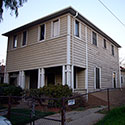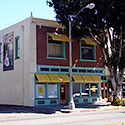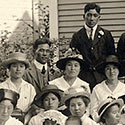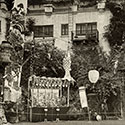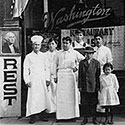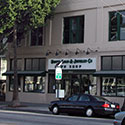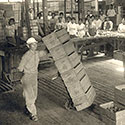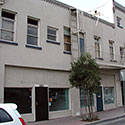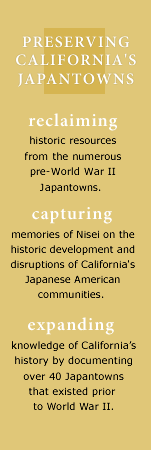 |
RiversideDuring the last decades of the 19th century, the city of Riverside was emerging as a major tourist attraction for wealthy easterners drawn to its warm winter climate and profitable investment opportunities in the growing citrus industry. Japanese immigrants also began arriving in the early 1890s to work in local citrus groves and packing houses, alongside Chinese and Mexican laborers. By 1910 Riverside’s residents lived in several clusters around the city and had a commercial life that included grocery stores, bicycle shops, restaurants, a fish market, cobbler and tailor. The majority of Riverside’s 580 Nikkei were single men whose needs were catered to by barbershops pool halls and rooming houses. Two labor contractors and three employment agents helped place as many as 3000 Japanese migrant laborers at the peak of citrus harvest season. One of these labor contractors, Ulysses Kaneko, was among the first Japanese to become naturalized citizens in California and was a leading community figure who worked as a court translator, grand juror, and board member of the Riverside Chamber of Commerce. Although anti-Asian sentiment and discrimination were not uncommon, Kaneko’s status may confirm some historians’ arguments that there were comparatively low levels of ethnic antagonism in Riverside. Yet, Riverside is also the location for one of the emblematic civil rights struggles by a Japanese immigrant, the Harada family’s battle to own their home on Lemon Street. ›› CLICK TO ENLARGE.
PROFILES
| ||||

The Harada House was designated a National Historic Landmark in 1990. In 2004, the Harada family donated their home to the City of Riverside, under the stewardship of the Riverside Metropolitan Museum, which is restoring the structure as the embodiment of "one family's struggle against all odds to achieve the American promise of freedom, citizenship, and a better life for their children."
In May 1913 the California Alien Land Law was passed prohibiting "aliens ineligible for citizenship" from long-term lease or purchase of real estate. While some Japanese immigrants were able to circumvent this law by purchasing property under the auspices of sympathetic Caucasians, or in the name of their American-born children, this legislation severely curtailed Nikkei economic and residential opportunities. In 1915, the Haradas sought to move from their cramped boarding house after losing a young son to diphtheria. Jukichi Harada purchased this home in a predominately Caucasian neighborhood in the names of his American-born children, knowing that the anti-immigrant law prevented him from buying it in his own name. After unsuccessfully trying to convince the Haradas to sell their home, several residents took the Haradas to local and state court. In the fall of 1918, a Riverside judge upheld the Alien Land Law, but ruled that American-born children of immigrants were entitled to all constitutional rights including property ownership. The Haradas continued to live in their Lemon Street home and operated their restaurant until they were forcibly relocated with all of Riverside’s Nikkei. Harold Harada, who served in the 442nd Regimental Combat Team, wrote "Evacuated on May 23, 1942 Sat;" an inscription still found on his former bedroom wall. Although the family lost their businesses, Jesse Stebler, a loyal customer of the Washington Restaurant, lived in the Harada home during the war years and returned it to the adult children when they came back after the war.

Jukichi Harada moved with his wife, Ken, and first child to Riverside in 1905. After working for Ulysses Kaneko at his Golden State Restaurant, the family opened their first restaurant and boarding house in 1909 on what was then known as Eighth Street. This 1911 photograph shows members of the Harada family proudly posed with staff and patrons on the sidewalk in front of their establishment. At far left, a portrait of George Washington, for whom the restaurant was named, appears in the storefront window. The Washington restaurant always served "American-style" food to complement the patriotic theme of its name, and the U.S. flag and portraits of American presidents that adorned the interior. Photo courtesy of the Riverside Metropolitan Museum, Harada Family Archival Collection.

The Haradas moved the Washington Restaurant to this structure in 1930, after briefly running their establishment from another building on West Ninth Street in 1925.

The structure where the Haradas opened their first restaurant and lived in the upper floor still stands today. The family also operated a number of rooming houses nearby that served Japanese and Mexican workers.

Unusual among California Japantowns, Riverside's Japanese-American community did not organize a Buddhist Church, although some Nikkei held services in private homes with a visiting minister. However, around 1900, Congregational and Methodist Missions were established to minister Japanese immigrants working in the Riverside area orange groves. This structure, built on land purchased before the turn of the century, was erected between 1901 and 1902 for the Japanese Mii Kyokai (Methodist Church). By 1917, Riverside's two Japanese churches merged as the Japanese Union Church. This photograph shows the congregation posed on the church steps around 1936, when the church sponsored Young Men and Women's Christian Associations, as well as one of two Japanese language schools in Riverside.
One Riverside Nisei recalled "For a long time, these churches prospered and became the focal point of the lives of the Japanese people in town because they had no other way to get together." The church was demolished in the late 1950s to make way for a new freeway. Photo courtesy of the Riverside Metropolitan Museum, Harada Family Archival Collection.

Agricultural work opened the door for many Japanese immigrants in the Riverside area. This 1910s photograph shows Nikkei workers in the Arlington Heights Fruit Company's Prenda packing house. Dozens of labor camps and packing houses in the Riverside area employed Japanese workers, who represented the largest number of citrus workers in Southern California. Photo courtesy of the Riverside Metropolitan Museum, Harada Family Archival Collection.

Built to realize the vision of eccentric entrepreneur and Japan enthusiast, Frank A. Miller, Riverside's grand Mission Inn often hosted special events for the Japanese American community, as well as visits by national figures such as President Theodore Roosevelt, industrialist Henry Ford, educator Booker T. Washington, and actress Sarah Bernhardt. Members of the local Japanese Association, which had been established in 1908, joined Miller and other Nikkei residents for annual banquets held at the hotel. During the 1920s and '30s, the Mission Inn hosted Boys' Day and Girls' Day festivities for the Japanese-American community. This image shows one of the hotel's interior courtyards decorated with banners, koi kites, and paper lanterns for the 1930 Boys' Day festivities. Photo courtesy of the Riverside Metropolitan Museum, Harada Family Archival Collection.

Preserving California's Japantowns' historic resources survey of Riverside, conducted by staff from the Riverside Metropilitan Museum, found very few sites based on our 1940-41 source materials; additional research guided by earlier sources, when Riverside's Japantown had a larger population, may yield additional findings.
Fuji Chop Suey, depicted above, was one of three restaurants listed in 1940-41 directories for Riverside. The local Japanese American population had declined from a high of nearly 600 in the 1910s to under 300 on the eve of WWII, in large part due to Japanese transitioning away from labor in the citrus groves and their replacement by Mexican American and Korean workers. The 1940 Japanese American directory listing included eight stores and markets, branch offices of three Nikkei newspapers, two pool halls, an insurance office, a dentist, and a flower shop. The Matsubara labor camp listing indicates that Japanese Americans were still involved in agricultural just before World War II.
